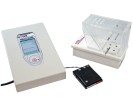Authors
Le Cudennec C, Castagné V
Lab
Porsolt S.A.S, France
Journal
Eur J Pharmacol.
Abstract
We compared the preclinical analgesic activity of three marketed drugs with different pharmacological properties, pregabalin, tramadol and duloxetine, described as effective against neuropathic pain in the clinic. These drugs were tested against evoked pain in two different neuropathic models in the rat, the Bennett (CCI) and the Chung (SNL) models. The selected endpoints were tactile allodynia, tactile hyperalgesia, heat hyperalgesia and cold allodynia. Although all three drugs displayed analgesic activity, the effects observed varied according to the behavioral evaluation. Pregabalin showed clear analgesic effects against cold allodynia and tactile hyperalgesia in both the CCI and Chung models. Tramadol was active against all four endpoints in the Chung model with similar effects in the CCI model, apart from tactile allodynia. Duloxetine inhibited tactile allodynia and heat hyperalgesia in both neuropathic pain models. It also displayed efficacy against tactile hyperalgesia in the CCI model and against cold allodynia in the Chung model. These data confirm that the CCI and the Chung models of neuropathic pain do not detect the activity of analgesics with the same sensitivity. Furthermore, the mode of stimulation (tactile or thermal) and the type of endpoint (allodynia or hyperalgesia) can further influence the observed efficacy of gold standards as well as novel compounds developed for treating neuropathic pain symptoms.
BIOSEB Instruments Used:
Static Weight Bearing Touch: Incapacitance Test (BIO-SWB-TOUCH-M)

 Pain - Thermal Allodynia / Hyperalgesia
Pain - Thermal Allodynia / Hyperalgesia Pain - Spontaneous Pain - Postural Deficit
Pain - Spontaneous Pain - Postural Deficit Pain - Mechanical Allodynia / Hyperalgesia
Pain - Mechanical Allodynia / Hyperalgesia Learning/Memory - Attention - Addiction
Learning/Memory - Attention - Addiction Physiology & Respiratory Research
Physiology & Respiratory Research
 Pain
Pain Central Nervous System (CNS)
Central Nervous System (CNS) Neurodegeneration
Neurodegeneration Sensory system
Sensory system Motor control
Motor control Mood Disorders
Mood Disorders Other disorders
Other disorders Muscular system
Muscular system Joints
Joints Metabolism
Metabolism Cross-disciplinary subjects
Cross-disciplinary subjects Preclinical studies and opioids: role in crisis management in the United States
Preclinical studies and opioids: role in crisis management in the United States 